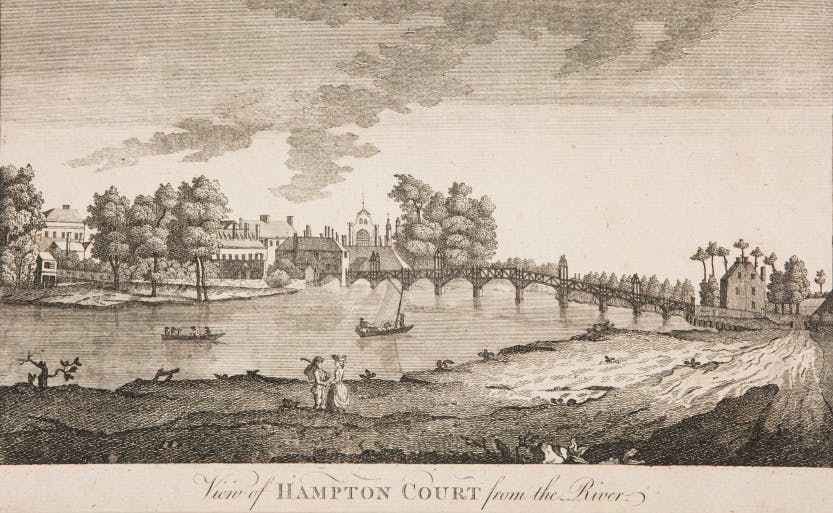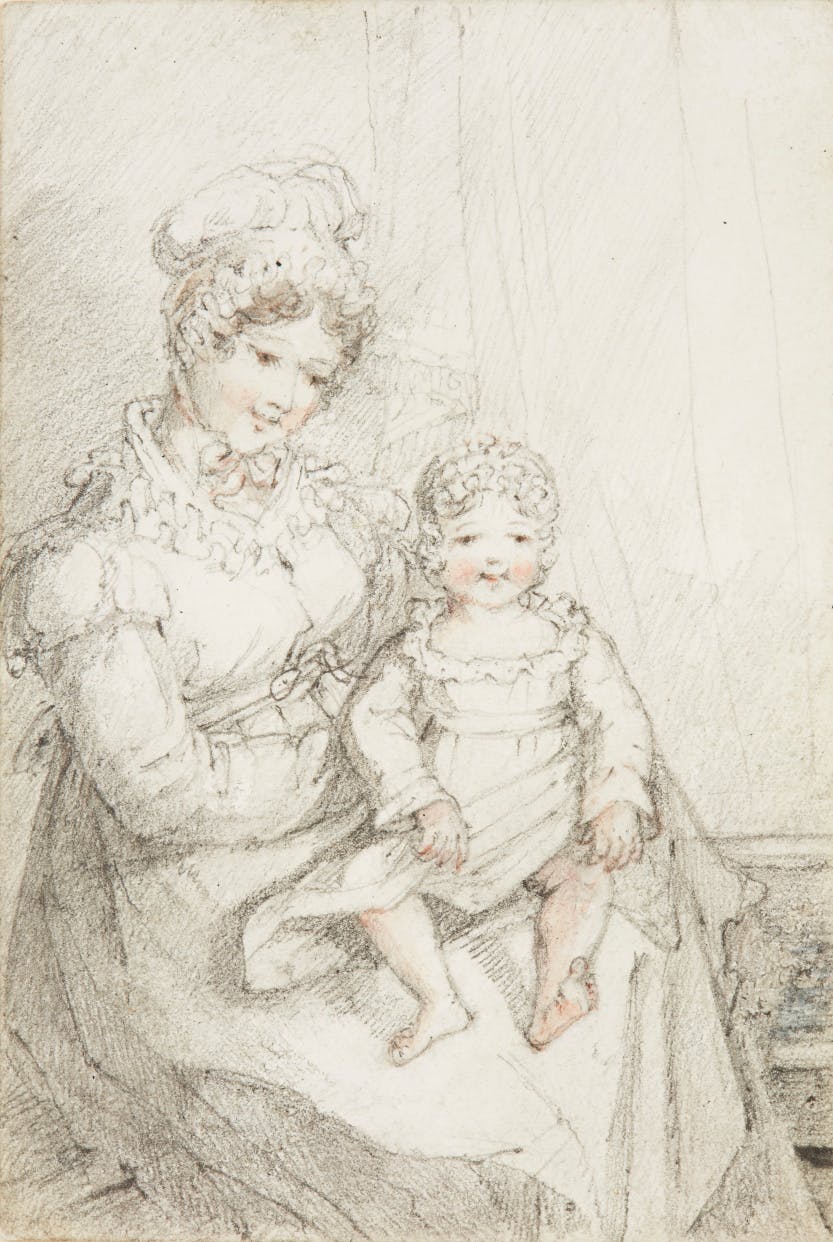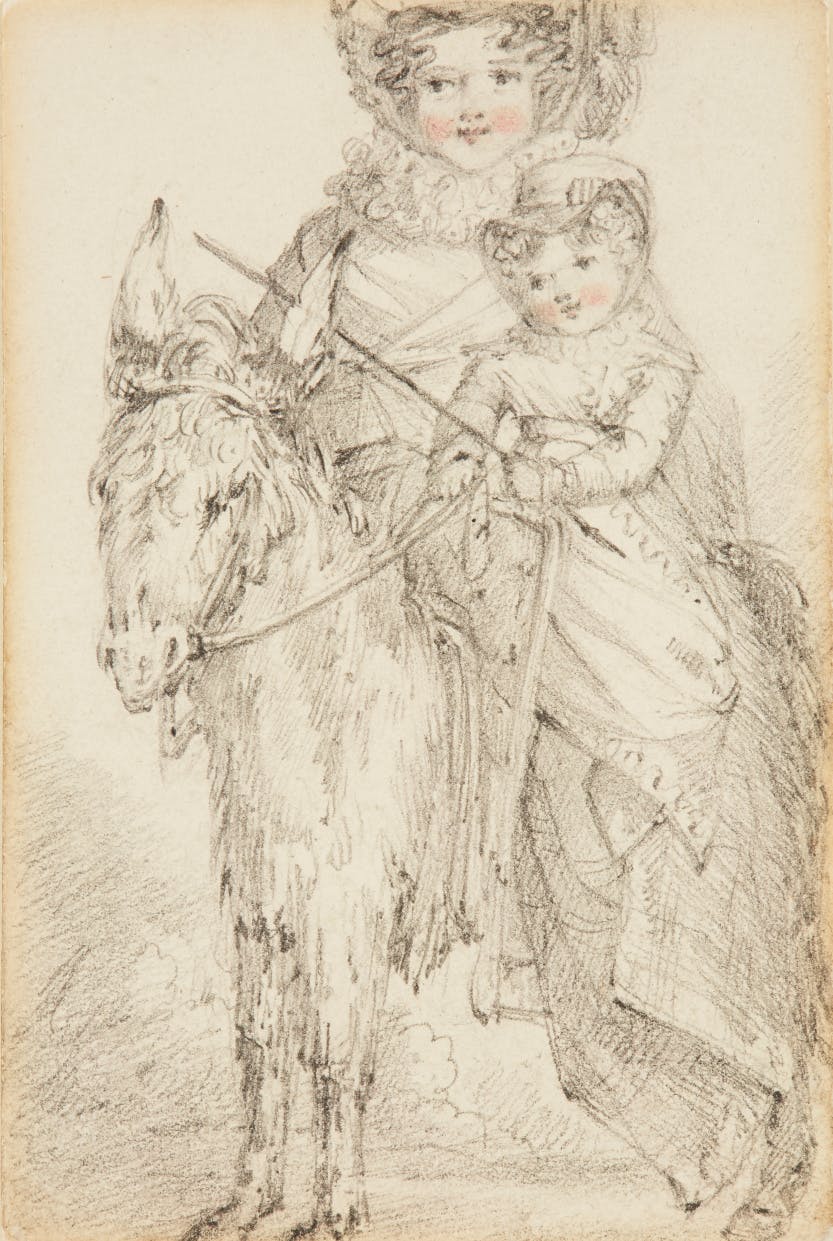Works of art on paper: a few stories behind the images
Date: 01 October 2019
Author:
Laurie Gibbs
When I give a talk about HRP's collection of works of art on paper, people usually think that our collection is mostly made up of views of the palaces and fusty portraits of Kings and Queens, and often, that is largely what it is. But the truth about many objects is that even if they are quite mundane in themselves, it is the stories behind the image which makes these items so fascinating.
For instance, this lovely view of Hampton Court, with a wooden bridge built in 1778. The bridge was demolished in 1840 after its owner appealed to the corporation of London to support the construction of a new bridge, describing his own old bridge as "crazy, hog-backed, inconvenient and obstructive of the navigation". He must have really wanted to build a new one!
I really like this 16th century etching of the three children of the King of Denmark, but not because of the picture itself but because of the scathing letter from Benedict Nicolson (son of Vita Sackville-West), then deputy surveyor of the King's collections, which I found attached to the back of the frame. George Virtue was an 18th century engraver who produced a catalogue of the Royal Collection pictures, but didn't seem to have checked all his facts or birth dates! He has incorrectly labelled the engraving as the children of Henry VII and Elizabeth of York, but Nicholson writes that, "Naturally, Vertue did not know what he was talking about."
What I want to show you are three portraits, which are among my favourites. These artworks are not the most beautiful in our collection, but they are linked by the tenderness and delicacy of the hand that drew them. Furthermore, these are painting not prints so they are unique.
This portrait of Queen Charlotte comes from a collection of sketches by William Hoare and dates back to around 1760 when the Queen was still in her teens. This was meant to be a preparatory drawing for an oil painting, but the portrait was never painted. It is a very gentle drawing, made with just pencil and watercolours, very different from the court paintings of Charlotte later in her life.
This picture of Queen Victoria as a child is part of a set of twelve bought at auction in 2016. It shows Queen Victoria sitting on her nurse's lap and was drawn by Lady Keith-Hiscote who was a friend of the family and who had a daughter of the same age. The drawings were made in 1822 while Lady Keith-Hiscote was staying with the royal family at Ramsgate on the Kent coast. The royal family stayed at Townley House in Chatham Street, and Victoria was allowed to play with other children and have donkey rides on the beach. Indeed, there is a small sketch of the future Queen Victoria on a donkey. In all twelve pictures Victoria is represented as this happy, rosy cheeked child, a very heart-warming look into her childhood.
This last portrait is a miniature of Lady Charlotte Finch and was painted by Princess Elizabeth, oldest daughter of George III, now part of the Royal Collection. Lady Charlotte was governess to all of George's children for 30 years. She was much loved by all the children and on all accounts a very progressive teacher who believed that girls should be as well educated as the boys. The children affectionately called her lady Cha. This painting is delicately and beautifully described, and I think really captures the intimate and fond relationship between the Princess and her governess.
Laurie Gibbs
Preventative Conservator
More from our blog

Conservation and discoveries in our paper collections
06 February 2020
We have around 25,000 works of art on paper in Historic Royal Palaces' collection. While many are on display, the vast majority are held in storage. These are delicate items and it's essential to conserve and store them correctly in order to preserve them for posterity.

Conservation of an 18th century headboard: Secrets of a State Bed
13 March 2020
As part of our Secrets of a State Bed series, Conservator Viola Nicastro explains the process of conserving the headboard of Queen Caroline's State Bed, and reveals more of its secrets.

Anthony Salvin: the architect who transformed the Tower of London
16 December 2021
Archivist Tom Drysdale introduces Anthony Salvin, the Victorian architect who began the transformation of the Tower of London, and looks at four drawings that shed a light on his work and legacy.



![Works of art on paper. Showing a letter originally attached to the back of the frame of the etching "The Children of Christian II, King of Denmark" 1748 after Jan Gossaert (c1478-1532). The letter from Benedict Nicolson, Deputy Surveyor of the King's Pictures, written in 1947, corrects the misidentification of the children in the portrait by engraver George Vertue as the children of King Henry VII and Elizabeth of York. [see also asset no. 68992]](https://hrp.imgix.net/https%3A%2F%2Fhistoricroyalpalaces.picturepark.com%2FGo%2FS5DMY51J%2FV%2F68994%2F29?auto=format&s=5ab77e2ac5306ef5dd3bb73b4285d79f)



